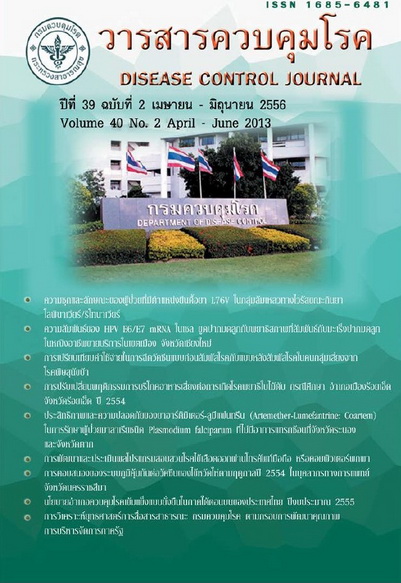Implementation of "Sustainable and Strengthening Disease-Control District" Policy in 7-Province Areas of Upper Southern Thailand, Fiscal Year 2555
DOI:
https://doi.org/10.14456/dcj.2013.37Keywords:
Sustainable and Strengthening Disease-Control District, Upper Southern ThailandAbstract
This evaluation research intended to: 1) analyze the content extent of "sustainable and strengthening disease-control district" policy in terms of validity, coverage, relevance, flexibility and feasibility. 2) examine the processes and procedures of policy implementation, and 3) evaluate the outcomes following the policy implementation in fiscal year 2012. The study areas encompassed seven provinces of upper southern region including Chumporn, Nakhon Si Thammarat, Suratthani, Krabi, Ranong, Phang-nga, Phuket. Data collection was carried out from November 2011 to July 2012. The entire 147 respondents from the government, local governments, and public sectors involving in implementing the policy at the provincial, district, and subdistrict levels were recruited to our study. Instruments applied were close- and open-ended questionnaires, query evaluation forms for assessing the system management mechanism of the province and the qualification of district by the 5 areas, relevant reports or documents regarding policy implementation. Data were analyzed using descriptive statistics and qualitative content. Research results of policy content analysis showed that the validity was at a high level while the coverage, relevance, flexibility and feasibility all were at the highest level. For the processes and procedures of downstream policy implementation, the evaluation revealed most implementers convey the policy by a conference and the convey messages were clear, comprehensive, and overspread. However, the strategies to convey were somewhat different among areas. Findings of an evaluation of two-year policy implementation impact showed all 7 provinces (100%) achieved two key performance indicators: 1) meet the provincial system management mechanism for the 5 components and 2) meet the 60% of qualified districts with the five areas. Of all 74 districts in the region, 69 districts (93.24%) met the criteria of qualified district. Important factors in the overall success of their driven policies included clear policy, efficient resource management and effective area-based responses, well support by leaders at all levels, continued supervision, monitoring and evaluation, best coordination, and strengthening networks and teams. The policy recommendations of this study were are: 1) to continue this policy implement by creating the Road map to guide the actors in gearing up the policy to the sub-district level, 2) to make an agreement of cooperation with the relevant ministries, and 3) to publicize widely. Recommendation from the assessment was is to evaluate the implementation of this policy in the coming years for the sake of the development plan and the achievement of the ultimate goal of policy "an effective, efficient, timely mechanism and system of diseases and health threats surveillance, prevention and control.
References
2. Millennium Ecosystem Assessment. Eosystems and human well-beings: Health synthesis 2005 [cited 1 December 2012]. Available from: http://www.millennium-ssessment.org/en/Synthesis.html.
3. มูลนิธิสถาบันวิจัยและพัฒนาผู้ สูงอายุไทย (มส.ผส.). รายงานประจำปี สถานการณ์ผู้สูงอายุไทย พ.ศ.2553. กรุงเทพฯ: ที คิว พี ; 2555 กุมภาพันธ์ 2555.
4. ปัญญาวัฒน์ สันติเวส. รายงานการประเมินผลระบบสุขภาพภาคประชาชน ปี 2547. พิมพ์ครั้งที่ 1 ed. นนทบุรี: กองสนับสนุนสุขภาพภาคประชาชน กรมสนับสนุนบริการสุขภาพ; 2547. 143 p.
5. World Health Organization. World Health Statistics: World Health Organization; 2012 [cited 1 December 2012]. Available from: http://www.who.int/about/ licensing/copyright_form/en/index.html.
6. กองทุนสนับสนุนสุขภาพภาคประชาชน, กรมสนับสนุนบริการสุขภาพ, กระทรวงสาธารณสุข, editors. การถ่ายโอนงานสุขภาพชุมชนสู่การกระจายอำนาจให้แก่องค์กรปกครองท้องถิ่น : การดำเนินงานสุขภาพภาคประชาชนในปี 2547. การประชุมวิชาการสุขภาพภาคประชาชน ครั้งที่ 1 "สร้างคนสร้างปัญญา สร้างสุขภาพชุมชน"; 2546; โรงแรมจอมเทียน ปาล์มบีช พัทยา จังหวัดชลบุรี: โรงพิมพ์ชุมนุมสหกรณ์การเกษตรแห่งประเทศไทย.
7. การกระจายอำนาจ : ยุทธศาสตร์. ประยงค์ เต็มชวาลา. การปฏิรูปงานสาธารณสุขไทย. นนทบุรี: สำนักงานสาธารณสุขเขต 10, 2540.
8. ตำรา : การสร้างเสริมสุขภาพแนวใหม่ (80 Yrs with Quality of Life). วิชัย เทียนถาวร. พิมพ์ครั้งที่ 2 ed. กรุงเทพฯ: โรงพิมพ์องค์การสงเคราะห์ทหารผ่านศึก; 2555. 470p.
9. Basarab Nicolescu. Transdisciplinarity: Theory and Practice. Cresskill, New Jersey, USA: Hampton Press; 2008.
10. มูลนิธิสาธารณสุขแห่งชาติ. นโยบายสาธารณะเพื่อคุณภาพชีวิตที่ดี : กระบวนการพัฒนาอย่างมีส่วนร่วม (Healthy Public Policy and Paticipatory Processes). กรุงเทพฯ: ที.เค.พริ้นติ้ง ; 2551. 182 p.
11. วิฑูรย์ อึ้งประพันธ์, อนุวัฒน์ ศุภชุติกุล, นวลอนันต์ ตันติเกตุ. นโยบายสาธารณะเพื่อสุขภาพ. พิมพ์ครั้งที่ 2 ed. อนุวัฒน์ ศุภชุติกุล, งามจิตต์ จันทรสาธิต, editors. กรุงเทพฯ: โครงการสำนักพิมพ์ สถาบันวิจัยระบบสาธารณสุข; 2541. 160 p.
12. Marmot M, Wilkinson R. Social determinants of health. Oxford: Oxford university press; 1999.
13. Willium H Forge. Social determinants of health and health-care solutions. Global Health Program, Bill and Melinda Gates Foundation, 2010.
14. กองแผนงาน. กรมควบคุมโรค. นโยบายและแนวทางการดำเนินงาน เพื่อสนับสนุนอำเภอควบคุมโรคเข้มแข็งแบบยั่งยืน. 2554.
15. สำนักจัดการความรู้. กรมควบคุมโรค. คู่มือการประเมินอำเภอควบคุมโรคเข้มแข็งแบบยั่งยืน สำหรับบุคลากร กรมควบคุมโรค. นนทบุรี 2555.
16. สำนักงานป้องกันควบคุมโรคที่ 11 จังหวัดนครศรีธรรมราช. ผลการประเมินอำเภอตามเกณฑ์คุณลักษณะ "อำเภอควบคุมโรคเข้มแข็งแบบยั่งยืน" ที่กรมควบคุมโรคกำหนด. นครศรีธรรมราช: 2555.
17. สำนักงานป้องกันควบคุมโรคที่ 11 จังหวัดนครศรีธรรมราช. เอกสารสรุปผลการนิเทศงานและการตรวจราชการกระทรวง. 2555.
18. ชัยนาท จิตตวัฒนะ. การประเมินแผนงานด้านสาธารณสุข : หลักการดำเนินงานเพื่อพัฒนากระบวนการบริหารเพื่อการพัฒนาสาธารณสุขของประเทศ. กรุงเทพฯ: ภาควิชาบริหารสาธารณสุข คณะสาธารณสุขศาสตร์ มหาวิทยาลัยมหิดล; 2540. 31 p.
19. การนำนโยบายไปปฏิบัติ (Policy implementation). วรเดช จันทรศร. พิมพ์ครั้งที่ 4 ed. กรุงเทพฯ: สหายบล็อกและการพิมพ์; 2543. 74 p.
20. การนำนโยบายไปปฏิบัติในระบบราชการไทย วรเดช จันทรศร. ลิขิต ธีรเวคิน. คณะรัฐประศาสนศาสตร์ สถาบันบัณฑิตพัฒนาบริหารศาสตร์; โครงการเอกสารและตำรา 2530.
Downloads
Published
How to Cite
Issue
Section
License
Articles published in the Disease Control Journal are considered as academic work, research or analysis of the personal opinion of the authors, not the opinion of the Thailand Department of Disease Control or editorial team. The authors must be responsible for their articles.



.png)



